Question
A patient with a pacemaker is mistakenly being scanned for an MRI image. A 10.0-cm-long section of pacemaker wire moves at a speed of 10.0 cm/s perpendicular to the MRI unit’s magnetic field and a 20.0-mV Hall voltage is induced. What is the magnetic field strength?
Final Answer
Solution video
OpenStax College Physics for AP® Courses, Chapter 22, Problem 30 (Problems & Exercises)

vote with a rating of
votes with an average rating of
.
Calculator Screenshots
Video Transcript
This is College Physics Answers with Shaun Dychko. A patient with a pacemaker is mistakenly being scanned for an MRI image and the reason this is a mistake is that the electronics inside the pacemaker are vulnerable to interference from the very high magnetic fields used in an MRI machine. So the interference is gonna be coming in the form of these induced voltages, these Hall voltages across the wires, and if the wires are in any coil then there might be induced currents through the magnetic field in a coil if the coil is moving or the magnetic field is changing. Anyhow we are told that imagine we have a wire that's 10.0 centimeters long inside the patient, which is 10.0 times 10 to the minus 2 meters, and it's moving at a speed of 10.0 centimeters per second and the induced Hall voltage across the width of the wire or across this diameter, in other words, is 20.0 millivolts and we will have to figure out what is the magnetic field strength being used in the MRI. So the Hall voltage is the magnetic field strength times the length of the wire multiplied by its speed and this is assuming that the velocity of the wire and the magnetic field direction are perpendicular and we divide both sides by l times v and we get then that magnetic field then is the Hall voltage divided by the length of the wire times its speed. So that's 20.0 times 10 to the minus 3 volts divided by 10.0 times 10 to the minus 2 meters of length times 10.0 times 10 to the minus 2 meters per second in speed and that is 2.00 tesla and this number is reasonable for an MRI machine. The highest reasonable voltage for a permanent magnet is about 0.5 tesla and MRI machines use superconducting wires carrying very high currents and that's how they are able to make magnetic fields on the order of 1.50 or 2.00 tesla.
